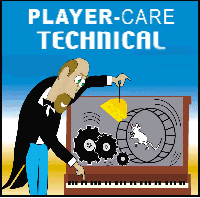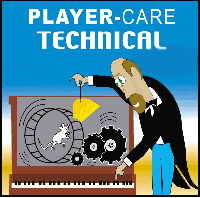
|

|

|

|

|

|
| Home | Manuals | Supplies | Search | Consult | Contact | Testing | Service |


Crash Valves in Exhauster Assemblies |
|
What is a Crash Valve? Basically, it's a valve that senses a sudden increase in the vacuum pressure inside of the Exhauster Assembly (or pumper assembly). What is the purpose of a Crash Valve? It's purpose is to make it easier for the user to accent specific notes or passages in the music. How does the Crash Valve work? Most simply stated, the Crash Valve redirects the vacuum being generated by the exhauster bellows (the foot pumps) from the reservoir bellow/s directly to the stack (or windchest), bypassing the reservoir. Where is the Crash Valve located? The crash valve is always located somewhere between the foot pump bellows and the reservoir bellows. Let me explain. Under normal circumstances, the vacuum being generated by the exhauster bellows (or foot pumps) is stored in the reservoir bellow/s. The reservoir bellows are spring loaded bellows, and as the vacuum level generated by the foot pumps increases, the vacuum level inside the reservoir increases and bellows collapse more. Also, the volume of the music is controlled by the level of the vacuum pressure inside of the reservoir bellow. The higer the pressure, the louder the music. However, when the user wants to accent a note or a short passage, they can push on the foot pedal/s faster or quickly, and the volume of the notes being played will increase. Generally speaking, the majority of player system manufacturers found this method of controlling the volume of the music adequate. When a crash valve is added to the system, the crash valve senses the sudden increase in vacuum pressure, being generated by the foot pumps, and it automatically bypasses the reseroir bellows and applies that increased vacuum pressure directly to the stack (or windchest). Below is a very detailed description of a crash valve. The graphics and explanation below were found in the 3rd Edition of the Standard Player Action Service Manual, which was published in 1925. Click on each image to see the full size page.
For more detailed information about the Standard Crash Valve, click here Some crash valves, like the one explained above, are quite simple. Others, which all claim to be better than someone elses design, can look quite complicated. But, they all perform the same basic function. As I get pictures of various crash valves, they will be added to this webpage along with the name of the company that made the device. Personally speaking, I don't like crash valves. I find that they limit my ability to add expression to the music and make it sound more life-like. The way I pump the pedals, to get the expression I like, is demonstrated in the video below.
|

![]() ..To
The Top of this Page . . . . . . . . . . .
..To
The Top of this Page . . . . . . . . . . . ![]() ..To The HOME Page
..To The HOME Page
|
Since "Player-Care" is an internet business, I prefer that we correspond via E-Mail (click here to fill out the 'Request Form'). However, if I'm not in the middle of some other activity, you can reach me at 732-840-8787. But please understand that during the hours from 8AM-5PM EST (Mon-Sat), I'm generally quite busy. So, I probably won't answer the phone. If you get the answering machine, please leave a detailed message stating the reason for your call. Also, repeat your name and phone number clearly and distinctly. By necessity, I prioritize everything in my life. And, if you call and just leave your name and number, and ask me to call you back, it might be a day or two before I return your call. Why? Because I don't know why you want me to call and I might not be prepared to assist you in an effective and efficient manner. If you leave me an E-Mail address (which I prefer), spell it out phonetically. The more you do to help me, the more I can help you in return. Don't rush. You have four minutes to record your message. |
|
407 19th Ave, Brick, NJ, 08724 Phone Number 732-840-8787 (Voicemail Only, No Texts) |
